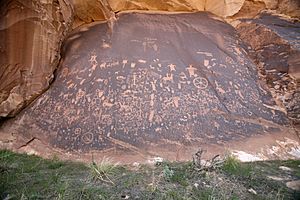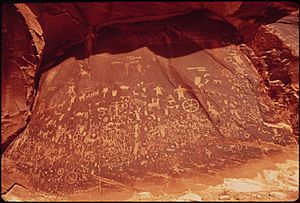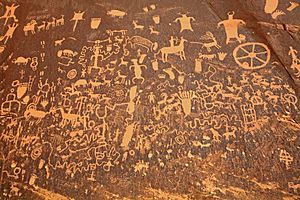Newspaper Rock State Historic Monument facts for kids
Quick facts for kids Newspaper Rock |
|
|---|---|
| Indian Creek State Park | |

Newspaper Rock in 2009
|
|
| Type | Petroglyph |
| Location | 20 Mi. SE of Canyonlands at Newspaper Rock State Park |
| Nearest city | Monticello |
| Area | Canyonlands NP |
| Elevation | 6080 ft |
| Owner | Utah State Parks Commission |
| Official name: Newspaper Rock State Historic Monument | |
| Designated | March 15, 1976 |
| Reference no. | 76001833 |
Newspaper Rock State Historic Monument is a Utah state monument featuring a rock panel carved with one of the largest known collections of petroglyphs. It is located in San Juan County, Utah, along Utah State Route 211, 28 miles (45 km) northwest of Monticello and 53 miles (85 km) south of Moab.
It is along the relatively well-traveled access road into the Needles district of Canyonlands National Park, 12 miles (19 km) from US 191 and 30 miles (48 km) from the park boundary. The 200-square-foot (19 m2) rock is a part of the vertical Wingate sandstone cliffs that enclose the upper end of Indian Creek Canyon, and is covered by hundreds of petroglyphs—one of the largest, best preserved and easily accessed groups in the Southwest. The petroglyphs feature a mixture of human, animal, material and abstract forms.
Newspaper Rock was designated a State Historical Monument in 1961, and was added to the National Register of Historic Places listings in San Juan County, Utah as Indian Creek State Park in 1976.
Petroglyphs
The first carvings at the Newspaper Rock site were made around 2,000 years ago, left by people from the Archaic, Anasazi, Fremont, Navajo, Anglo, and Pueblo cultures.
In Navajo, the rock is called "Tse' Hone'" which translates to a rock that tells a story.
The petroglyphs were carved by Native Americans during both the prehistoric and historic periods. There are over 650 rock art designs. The drawings on the rock are of different animals, human figures, and symbols. These carvings include pictures of deer, buffalo, and pronghorn antelope. Some glyphs depict riders on horses, while other images depict past events like in a newspaper. While precisely dating the rock carvings has been difficult, repatination of surface minerals reveals their relative ages. The reason for the large concentration of the petroglyphs is unclear.
The pictures at Newspaper Rock were inscribed into the dark coating on the rock, called desert varnish. Desert varnish is a blackish manganese-iron deposit that gradually forms on exposed sandstone cliff faces owing to the action of rainfall and bacteria. The ancient artists produced the many types of figures and patterns by carefully pecking the coated rock surfaces with sharpened tools to remove the desert varnish and expose the lighter rock beneath. The older figures are themselves becoming darker in color as new varnish slowly develops.
Images for kids




